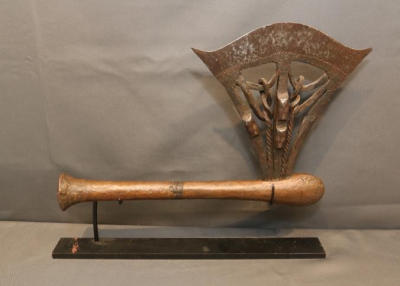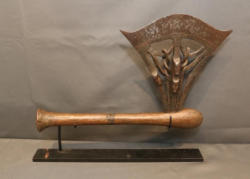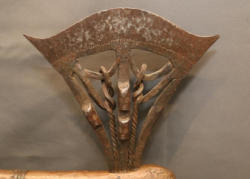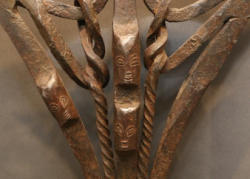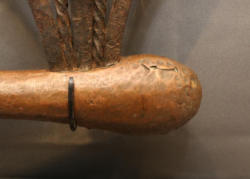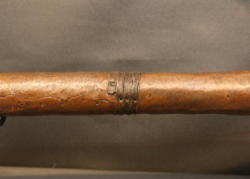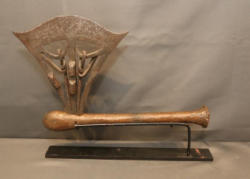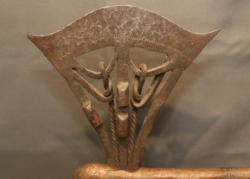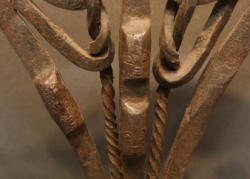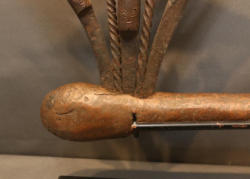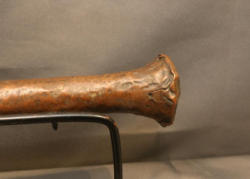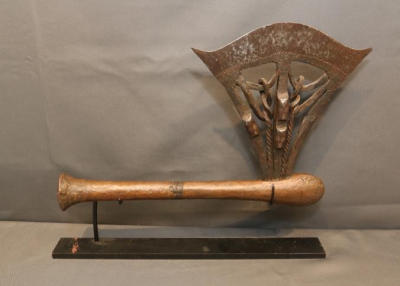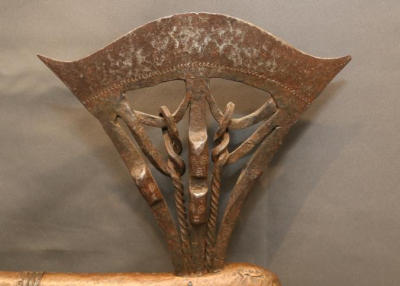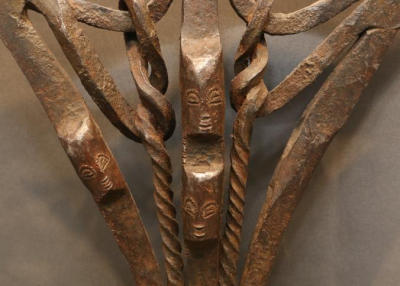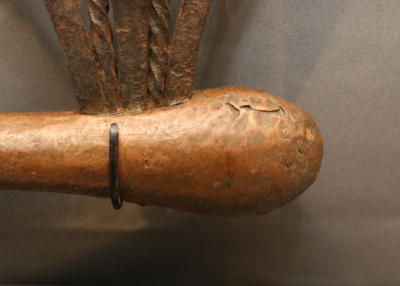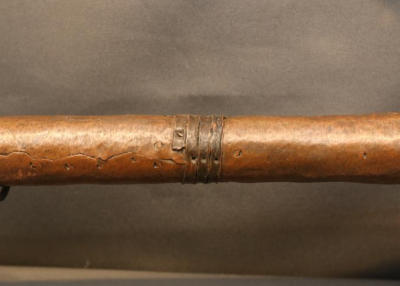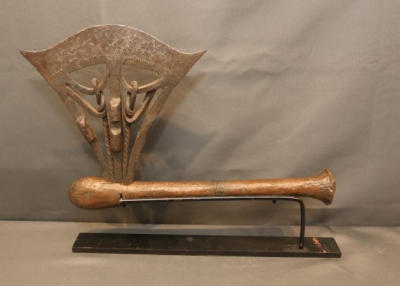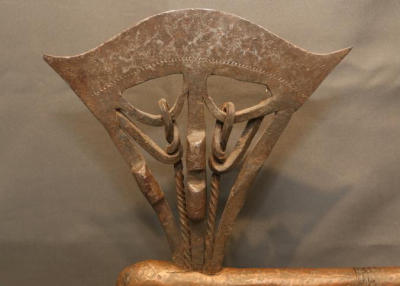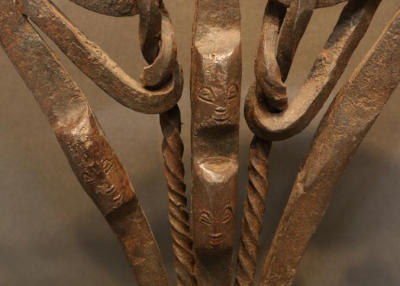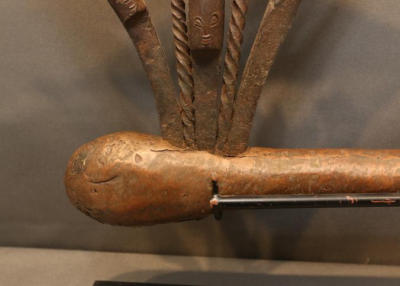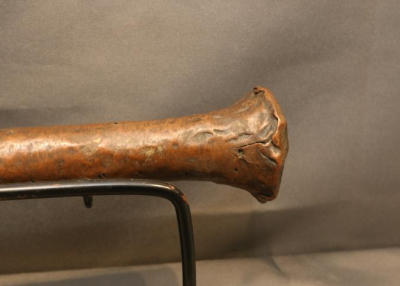Items located in Pleasant Valley, NY. Items include wall plaque from the royal palace, Edo people, Benin; rare masterwork ceremonial ax, Sapo-Sapo/Songye people, Congo; prestige neck ring, Kirdi or Fali people, Nigeria; West African anklet and bracelet bells; late 19thC gold weights, Akan people; and more.
AFRICAN ART COLLECTION OF MARY SUE AND PAUL PETER ROSEN
Mary Sue and Paul Peter Rosen have collected African art for over thirty years, making nine trips to Africa to study the art in its cultural setting. The Rosens have published three African art books, curated more than ten exhibitions from their collection, and have given public lectures about African art and culture. They have donated art from their collection to various institutions including the Newark Museum, Temple University in Philadelphia, the SMA Fathers African Art Museum in Tenafly, New Jersey, and the African American Research Library in Fort Lauderdale, Florida.
Payment is due by Monday, June 3 at 1PM.
Pickup in Pleasant Valley, NY must be completed by Monday, June 3 at 3PM.
All lots sold as is, where is. There is a 15% Buyers Premium for all lots purchased. Payment methods include cash, MC, Visa, Discover or good check. You can make credit card payment online by going to your Member Area and selecting your invoice.
*NOTE* Shipping is available on all items.
AFRICAN ART COLLECTION OF MARY SUE AND PAUL PETER ROSEN
Mary Sue and Paul Peter Rosen have collected African art for over thirty years, making nine trips to Africa to study the art in its cultural setting. The Rosens have published three African art books, curated more than ten exhibitions from their collection, and have given public lectures about African art and culture. They have donated art from their collection to various institutions including the Newark Museum, Temple University in Philadelphia, the SMA Fathers African Art Museum in Tenafly, New Jersey, and the African American Research Library in Fort Lauderdale, Florida.
Payment is due by Monday, June 3 at 1PM.
Pickup in Pleasant Valley, NY must be completed by Monday, June 3 at 3PM.
All lots sold as is, where is. There is a 15% Buyers Premium for all lots purchased. Payment methods include cash, MC, Visa, Discover or good check. You can make credit card payment online by going to your Member Area and selecting your invoice.
*NOTE* Shipping is available on all items.
Auction Info
Items located in Pleasant Valley, NY. Items include wall plaque from the royal palace, Edo people, Benin; rare masterwork ceremonial ax, Sapo-Sapo/Songye people, Congo; prestige neck ring, Kirdi or Fali people, Nigeria; West African anklet and bracelet bells; late 19thC gold weights, Akan people; and more.
AFRICAN ART COLLECTION OF MARY SUE AND PAUL PETER ROSEN
Mary Sue and Paul Peter Rosen have collected African art for over thirty years, making nine trips to Africa to study the art in its cultural setting. The Rosens have published three African art books, curated more than ten exhibitions from their collection, and have given public lectures about African art and culture. They have donated art from their collection to various institutions including the Newark Museum, Temple University in Philadelphia, the SMA Fathers African Art Museum in Tenafly, New Jersey, and the African American Research Library in Fort Lauderdale, Florida.
Payment is due by Monday, June 3 at 1PM.
Pickup in Pleasant Valley, NY must be completed by Monday, June 3 at 3PM.
All lots sold as is, where is. There is a 15% Buyers Premium for all lots purchased. Payment methods include cash, MC, Visa, Discover or good check. You can make credit card payment online by going to your Member Area and selecting your invoice.
*NOTE* Shipping is available on all items.
AFRICAN ART COLLECTION OF MARY SUE AND PAUL PETER ROSEN
Mary Sue and Paul Peter Rosen have collected African art for over thirty years, making nine trips to Africa to study the art in its cultural setting. The Rosens have published three African art books, curated more than ten exhibitions from their collection, and have given public lectures about African art and culture. They have donated art from their collection to various institutions including the Newark Museum, Temple University in Philadelphia, the SMA Fathers African Art Museum in Tenafly, New Jersey, and the African American Research Library in Fort Lauderdale, Florida.
Payment is due by Monday, June 3 at 1PM.
Pickup in Pleasant Valley, NY must be completed by Monday, June 3 at 3PM.
All lots sold as is, where is. There is a 15% Buyers Premium for all lots purchased. Payment methods include cash, MC, Visa, Discover or good check. You can make credit card payment online by going to your Member Area and selecting your invoice.
*NOTE* Shipping is available on all items.
Categories:
RARE MASTERWORK CEREMONIAL AX. Sapo-Sapo/Songye people, Congo. The Sapo-Sapo and Songye are neighboring ethnic groups who share a number of cultural attributes, including ceremonial ax forms. This ax, a masterwork of a highly skilled blacksmith, would only be made for and available to a high ranking, wealthy member of the community. Given the ?primitive? tools available to African blacksmith?s in the mid-19th century when this ax was made, it should be considered equal to some of the work of the greatest European blacksmiths of the same time period. The wooden handle is entirely tightly covered in a hammered thin copper sheath and wrapped with copper wire at mid-shaft. The flared blade is supported by three struts: a straight one in the center and a curved strut on either side. A unique feature of the Sapo-Sapo/Songye ax is the images of faces on both sides of the three struts. Often, there are only 4 faces, two on each side. This ax is exceptional in that there are two faces on each side of the central strut and one on each side of a lateral strut, making a total of 6 faces. The faces are thought to represent important male ancestors who lend support to the authority of the owner of the ax. The blade is also supported by two twisted struts which are entwined with semi-lunar horizontal bars that resemble curtain swags. On custom base. H16.5in. Ex Dalton-Somaré Collection Milan, Italy.
More Details
RARE MASTERWORK CEREMONIAL AX. Sapo-Sapo/Songye people, Congo. The Sapo-Sapo and Songye are neighboring ethnic groups who share a number of cultural attributes, including ceremonial ax forms. This ax, a masterwork of a highly skilled blacksmith, would only be made for and available to a high ranking, wealthy member of the community. Given the ?primitive? tools available to African blacksmith?s in the mid-19th century when this ax was made, it should be considered equal to some of the work of the greatest European blacksmiths of the same time period. The wooden handle is entirely tightly covered in a hammered thin copper sheath and wrapped with copper wire at mid-shaft. The flared blade is supported by three struts: a straight one in the center and a curved strut on either side. A unique feature of the Sapo-Sapo/Songye ax is the images of faces on both sides of the three struts. Often, there are only 4 faces, two on each side. This ax is exceptional in that there are two faces on each side of the central strut and one on each side of a lateral strut, making a total of 6 faces. The faces are thought to represent important male ancestors who lend support to the authority of the owner of the ax. The blade is also supported by two twisted struts which are entwined with semi-lunar horizontal bars that resemble curtain swags. On custom base. H16.5in. Ex Dalton-Somaré Collection Milan, Italy.
High Bid:
$600.00 – erikfarrow
Auction Type: One Lot
Quantity: 1
Bidding has closed on this lot

